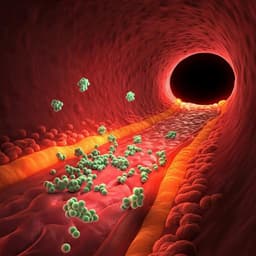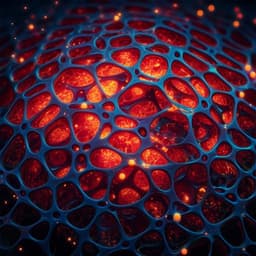
Chemistry
Hydrogen spillover-driven synthesis of high-entropy alloy nanoparticles as a robust catalyst for CO₂ hydrogenation
K. Mori, N. Hashimoto, et al.
This groundbreaking research by Kohsuke Mori and team unveils the low-temperature synthesis of CoNiCuRuPd high-entropy alloy nanoparticles on titanium dioxide. With remarkable activity and durability in CO₂ hydrogenation, the study offers exciting insights into the catalytic potential of these alloy nanoparticles, driven by unique synergistic effects.
~3 min • Beginner • English
Introduction
The study addresses the challenge of synthesizing nanometer-scale high-entropy alloy (HEA) nanoparticles on conventional supports at low temperature. HEAs, comprising five or more near-equimolar elements, offer unique synergistic effects (high configurational entropy, lattice distortion, sluggish diffusion, and cocktail effects) that yield exceptional mechanical and chemical properties. While bulk HEAs are accessible by melting, solid-state processing, and additive manufacturing, reliably producing sub-10 nm HEA nanoparticles with uniform composition and size for catalytic applications remains difficult, often requiring extreme temperatures or specialized apparatus. The authors hypothesize that leveraging hydrogen spillover on reducible TiO₂ can drive the simultaneous low-temperature reduction of multiple metal precursors to form uniform, supported CoNiCuRuPd HEA nanoparticles. The work aims to develop a simple impregnation–reduction protocol, elucidate the spillover-driven formation mechanism, and evaluate catalytic activity and durability in CO₂ hydrogenation.
Literature Review
Prior HEA nanoparticle syntheses include carbothermal shock (flash heating to ~2000 K with rapid quenching) enabling up to 8-element alloys on carbon nanofibers, ultrasonication-assisted, solvothermal, polyol, and fast moving bed pyrolysis methods. These typically require high temperatures, rapid transients, or specialized equipment. Hydrogen spillover—surface migration of dissociated H atoms—proceeds efficiently on reducible oxides (TiO₂, WO₃, MoO₃) via coupled proton/electron transfer, but is limited on non-reducible oxides (e.g., Al₂O₃). TiO₂ supports enable long-distance, rapid spillover relative to Al₂O₃. The authors’ previous work used TiO₂ spillover to form nonequilibrium binary alloys (RuNi, RhCu) from immiscible pairs by using noble metals to generate reactive hydrogen that reduces base metals. These insights motivate extending spillover to multi-element HEA formation on TiO₂. HEA formation criteria (atomic size difference δ < 6.6% and mixing enthalpy between −11.6 and 3.2 kJ/mol) inform element selection; the chosen CoNiCuRuPd combination meets these (δ ≈ 3.9% and ΔH_mix ≈ 1.1 kJ/mol).
Methodology
Synthesis: CoNiCuRuPd/TiO₂ was prepared by incipient wetness impregnation from aqueous precursors (RuCl₂H₂O, Cu(NO₃)₂·3H₂O, Co(NO₃)₂·6H₂O, Ni(NO₃)₂·6H₂O, Na₂PdCl₄) onto rutile TiO₂ (JRC-TIO-6). For 0.5 g TiO₂, 4.75 mL of each 10 mM metal solution was added in water (100 mL), stirred 1 h at room temperature, solvent removed under vacuum, then reduced under 20 mL/min H₂ at 400 °C for 2 h. Metal loading: Pd 1.0 wt%; molar ratio Co:Ni:Cu:Ru:Pd = 1:1:1:1:1. Analogous preparations were performed on Al₂O₃ and MgO supports and for Pd/TiO₂ (1 wt% Pd). Element selection considered standard reduction potentials (E° vs NHE: Co²⁺/Co −0.28 V, Ni²⁺/Ni −0.26 V, Cu²⁺/Cu +0.34 V, Ru³⁺/Ru +0.46 V, Pd²⁺/Pd +0.99 V) and HEA formation rules.
Characterization: H₂-TPR (BEL-CAT) on as-deposited samples (5% H₂/Ar, 50→600 °C, 5 °C/min). In situ XAFS (XANES/EXAFS) at Co, Ni, Cu, Ru, Pd K-edges and in situ XRD at SPring-8 (01B1 beamline; Si(111) monochromator) under H₂ at elevated temperatures using a batch in situ cell (REX2000 for data processing). XRD for phase identification. TEM/STEM-HAADF with EDX mapping/line analysis (Hitachi HF-2000; JEOL-ARM 200F). CO-TPD FTIR (JASCO FT/IR-6600) to probe CO adsorption strength and desorption temperature. ETEM (Titan ETEM G2) with Cs-corrector and K3-IS camera; 300 kV, 2 A/cm², base pressure <1×10⁻⁵ Pa, to assess beam-induced atomic mobility.
Catalytic testing: Fixed-bed quartz reactor (ID 17 mm), 50 mg catalyst. Pretreatment: 20 mL/min H₂, 5 °C/min to 400 °C, 2 h. Reaction: atmospheric pressure, feed N₂/H₂/CO₂ = 4/5/1 (total 50 mL/min; space velocity 6000 mL g⁻¹ h⁻¹), 300–400 °C. Online GC (active carbon column, TCD then FID with methanizer) to quantify CO and CH₄.
Computations: DFT (DMol³, PBE-GGA, DNP basis) slab models. Spillover mechanism on rutile TiO₂(101) with Pd₅ cluster (square pyramidal) to evaluate energy barriers for: H₂ dissociation on Pd (Step 1), H transfer to TiO₂ (Step 2), H migration over O(2)/O(3) sites (Step 3), reduction of surface Mⁿ⁺–OH (M = Co²⁺, Ni²⁺, Cu²⁺, Ru³⁺, Pd²⁺) by spillover H (Step 4), and cluster formation (Step 5). Comparison of H₂ dissociation and Co²⁺ reduction on TiO₂ without Pd and H migration on Al₂O₃ surfaces (hexagonal Al₂O₃(100), γ-Al₂O₃ model). CO vibrational frequencies and adsorption energies E_ad for CO and H on CoNiCuRuPd(111) HEA slabs (random (111) site configurations) and pure metal slabs (Co(001), Ni(111), Cu(111), Ru(001), Pd(111)). Cohesive energies (CASTEP, PBE, ultrasoft pseudopotentials, cutoff 351 eV) for clusters: HEA Co₁₆Ni₁₅Cu₁₆Ru₁₆Pd₁₆ vs monometallic M₇₉/M₈₁. DFT-MD (CASTEP, NVE, 900 K, 1 fs, 100 steps) to compute diffusion coefficients from mean-square displacement.
Key Findings
- Spillover-driven HEA formation on TiO₂: H₂-TPR of quinary precursors on TiO₂ showed a single reduction peak centered ~170 °C, indicating simultaneous reduction and interaction among all five metals. On non-reducible MgO and Al₂O₃, broad peaks (130–250 °C) indicated non-synchronous reduction and segregation.
- In situ XAFS: All precursors reduced by 200 °C (mixed cation/metal at Co, Ni K-edges) and fully metallic by 400 °C; subtle post-edge shifts (e.g., Pd K-edge 1s→5p peaks shifted to higher energy) indicated lattice disorder due to multi-element mixing. FT-EXAFS revealed transition from M–O (~1.7–1.9 Å) to metallic M–M bonds; Ru K-edge shoulder at ~1.9 Å suggested Ru–M shorter bonds; mixed metallic neighbors indicated random alloying.
- Structure/size: XRD showed a single fcc phase (a = 3.734 Å) with broad peaks at 2θ = 42.2° (111) and 48.9° (200); no separate Co, Ni, Cu, Ru, or Pd peaks. STEM-HAADF gave average NP diameter d_ave = 1.90 nm on TiO₂ with uniform Co, Ni, Cu, Ru, Pd distribution by EDX maps/line scans. On Al₂O₃ and MgO, d_ave = 6.65 and 6.73 nm with partial segregation (MgO).
- Mechanism evidence: In situ XRD at 200 °C showed Pd(111)/(200) peaks that disappeared at higher T as HEA peaks grew; Pd K-edge FT-EXAFS at 200 °C showed strong Pd–Pd that shifted to shorter distance with T, indicating initial Pd nuclei and subsequent interdiffusion to HEA (Pd_core–M_shell intermediate).
- DFT energetics (TiO₂(101) with Pd₅): Step 1 H₂ dissociation barrier 20.1 kcal/mol; Step 2 H transfer Pd→TiO₂ 27.5 kcal/mol; Step 3 H migration barriers: O(2)→O(2) 15.0, O(2)→O(3) 37.4, O(3)→O(2) 12.7 kcal/mol (migration prefers O(2) sites); Step 4 reduction barriers for Mⁿ⁺–OH: Co²⁺ 12.7, Ni²⁺ 12.7, Cu²⁺ 12.6, Ru³⁺ 8.0, Pd²⁺ 7.4 kcal/mol; Step 5 cluster formation barrier <11.1 kcal/mol. Without Pd: H₂ dissociation on TiO₂(101) 82.3 kcal/mol; direct Co²⁺ reduction by H₂ 85.3 kcal/mol. On Al₂O₃, H migration barriers 29.3–43.8 kcal/mol (also ~38.9 kcal/mol on γ-Al₂O₃ model), much higher than TiO₂.
- Catalysis (CO₂ hydrogenation, 1 atm, 300–400 °C, N₂/H₂/CO₂=4/5/1): CoNiCuRuPd/TiO₂ gave highest hydrogenated product yields, 2× and 13× those on MgO and Al₂O₃ supports, respectively. Selectivity at 400 °C: CoNiCuRuPd/TiO₂ CH₄ 68.3%; Al₂O₃-supported quinary 72.1% CH₄; MgO-supported quinary 75.2% CO. Pd/TiO₂ showed lower activity, CO as primary product. Apparent activation energy: 37.7 kJ/mol (HEA/TiO₂) vs 44.2 kJ/mol (Pd/TiO₂). Monometallic Co/TiO₂, Ni/TiO₂, Cu/TiO₂ were practically inactive (<1% yield), Ru/TiO₂ was active (yields 48.5%, 61.6%, 66.1% at 300, 350, 400 °C) attributed to very small Ru NPs (d_ave ≈ 0.89 nm).
- CO adsorption/desorption: FTIR-TPD ν_CO for Pd/TiO₂ 2091 cm⁻¹ with desorption onset ~50 °C; HEA/TiO₂ ν_CO 2070 cm⁻¹ with desorption >150 °C. DFT: average ν_CO on HEA(111) 2079 cm⁻¹. E_ad (kcal/mol): HEA_avg CO −37.5, H −50.3; Pd(111) CO −26.2, H −54.2. Thus, stronger CO binding on HEA promotes further hydrogenation to CH₄ (cocktail effect), while Pd favors CO desorption.
- Durability/sluggish diffusion: Over 72 h, relative activity decreased to 0.76 (Pd/TiO₂) and 0.89 (Ru/TiO₂), while HEA/TiO₂ retained 0.96 with constant selectivity. TEM after 72 h: Pd/TiO₂ NPs grew from ~2.0 to 5.3 nm; HEA/TiO₂ from 1.9 to 2.3 nm with preserved random elemental distribution. ETEM under electron beam showed minimal contrast changes for HEA NPs vs pronounced changes for Pd NPs, indicating suppressed beam-induced atomic displacement. DFT cohesive energies: HEA cluster −3.92 eV vs Pd₇₉ −3.09 eV. MD diffusion coefficients at 900 K: all elements in HEA had lower D than in monometallic clusters; e.g., Pd in HEA D = 1.31×10⁻⁵ m²/s vs 3.43×10⁻⁵ m²/s in Pd₇₉, supporting sluggish diffusion and robustness.
Discussion
The results demonstrate that reducible TiO₂ enables hydrogen spillover that drives the synchronized, low-temperature reduction of multiple metal precursors to form uniform, sub-2 nm CoNiCuRuPd HEA nanoparticles. In situ spectroscopy and diffraction corroborate a mechanism where Pd²⁺ reduces first to nuclei that dissociate H₂; spillover H migrates across TiO₂ via coupled proton/electron transfer to reduce neighboring cations simultaneously, avoiding sequential reduction and segregation seen on non-reducible supports. DFT energetics validate low barriers for H₂ activation on Pd, H transfer and migration on TiO₂, and cation reduction, and highlight the unfavorable energetics without Pd or on Al₂O₃, explaining the support dependence. In CO₂ hydrogenation, the HEA/TiO₂ exhibits higher activity (lower apparent activation energy) and CH₄ selectivity compared to Pd/TiO₂ due to stronger CO adsorption on HEA surfaces (confirmed by FTIR and DFT), which facilitates further hydrogenation of CO intermediates (cocktail effect). The HEA also exhibits exceptional durability, maintaining activity and inhibiting particle growth over 72 h, attributable to sluggish diffusion and higher cohesive energy arising from multi-element mixing and lattice distortion. Preliminary TPR data with other noble-metal-containing quinary systems on TiO₂ suggest broader applicability of the spillover-assisted HEA synthesis strategy.
Conclusion
This work establishes a simple, low-temperature impregnation–reduction route on TiO₂ that exploits hydrogen spillover to synthesize supported CoNiCuRuPd HEA nanoparticles with single-phase fcc structure, ~1.9 nm size, and homogeneous elemental mixing. The HEA/TiO₂ catalyst displays superior activity, methane selectivity, and markedly improved stability for CO₂ hydrogenation compared to Pd/TiO₂, underpinned by stronger CO binding (cocktail effect) and sluggish atomic diffusion. In situ experiments and DFT calculations elucidate the spillover-driven formation mechanism and the origins of robustness. The approach promises a broadly applicable platform for fabricating HEA catalysts with diverse compositions and potentially for catalyst/photocatalyst architectures across an expanded compositional space. Future work should extend the method to other element combinations (e.g., Rh, Pt, Au systems indicated by TPR), supports, and reactions, and assess long-term performance under industrially relevant conditions.
Limitations
- Generality beyond CoNiCuRuPd/TiO₂ is suggested but not fully demonstrated; preliminary TPR with other quinary systems implies feasibility without full structural and catalytic validation. - The mechanism is supported by model DFT calculations (Pd₅ on TiO₂(101)) that approximate realistic surfaces and particle sizes; actual catalyst surfaces may include other facets/defects. - Durability assessments were conducted over 72 h at atmospheric pressure; longer-term and higher-pressure evaluations are needed for industrial relevance. - Beam-induced stability comparisons via ETEM are qualitative; the authors note that precise quantification of atomic columns requires more extensive statistical analysis. - Support effects were evaluated for TiO₂ vs Al₂O₃/MgO; other reducible supports (e.g., CeO₂, WO₃, MoO₃) were not explored experimentally.
Related Publications
Explore these studies to deepen your understanding of the subject.







